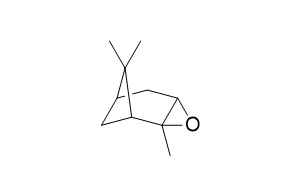alpha-Pinene oxide
alpha-Pinene oxide shows low levels of inhibition on bacterial activities in nature.
Inquire / Order:
manager@chemfaces.com
Technical Inquiries:
service@chemfaces.com
Tel:
+86-27-84237783
Fax:
+86-27-84254680
Address:
1 Building, No. 83, CheCheng Rd., Wuhan Economic and Technological Development Zone, Wuhan, Hubei 430056, PRC
Providing storage is as stated on the product vial and the vial is kept tightly sealed, the product can be stored for up to
24 months(2-8C).
Wherever possible, you should prepare and use solutions on the same day. However, if you need to make up stock solutions in advance, we recommend that you store the solution as aliquots in tightly sealed vials at -20C. Generally, these will be useable for up to two weeks. Before use, and prior to opening the vial we recommend that you allow your product to equilibrate to room temperature for at least 1 hour.
Need more advice on solubility, usage and handling? Please email to: service@chemfaces.com
The packaging of the product may have turned upside down during transportation, resulting in the natural compounds adhering to the neck or cap of the vial. take the vial out of its packaging and gently shake to let the compounds fall to the bottom of the vial. for liquid products, centrifuge at 200-500 RPM to gather the liquid at the bottom of the vial. try to avoid loss or contamination during handling.
Life (Basel).2022, 12(10):1630.
Nat Prod Commun.2014, 9(5):679-82
Biomed Pharmacother.2021, 137:111362.
Toxicol In Vitro.2024, 99:105876.
University of Manitoba2023, 37433.
Int J Mol Sci.2021, 22(14):7324.
Int J Mol Sci.2021, 22(8):4211.
Plos One.2020, 10.1371
Int J Mol Sci.2020, 21(7):2530.
Trop J Nat Prod Res, February2023, 7(2):2371-2381
Related and Featured Products
Applied Microbiology & Biotechnology, 2003, 60(5):534-40.
Optimization of isonovalal production from alpha-pinene oxide using permeabilized cells of Pseudomonas rhodesiae CIP 107491.[Pubmed:
12536252]
METHODS AND RESULTS:
Optimization studies on the synthesis of isonovalal from alpha-Pinene oxide by Pseudomonas rhodesiae CIP 107491 operated in a biphasic medium are presented. Three key parameters are identified. The first is the need for a permeabilization of cells by freezing them and then treating the thawed material with an organic solvent such as chloroform, toluene or diethyl ether. This operation allows both enzyme release into the aqueous phase outside the cells and an improvement in the transport properties of both substrate and product across the cell membrane, strongly increasing reaction rates. The second is that the enzyme alpha-Pinene oxide lyase, which exhibits an irreversible inactivation by isonovalal (or a by-product), presents a constant turn-over, i.e., the total product synthesis is proportional to the biomass loading and is close to 108 mmol (16.4 g) isonovalal l(-1) g(-1) biomass. The third phenomenon is that the biphasic system used is not phase-transfer-limited, a feature attributed to the spontaneous formation of an oil-in-water emulsion.
CONCLUSIONS:
It is thus possible to carry out a very efficient process, allowing the recovery of 2.63 mol isonovalal l(-1) (400 g l(-1)) from 25 g biomass l(-1) in 2.5 h, corresponding to an average reaction rate as high as 0.70 mmol min(-1) g(-1) cells (160 g l(-1) h(-1)).
Appl.environ.microbiol, 1998, 64(9):520-525.
Effect of selected monoterpenes on methane oxidation, denitrification, and aerobic metabolism by bacteria in pure culture.[Pubmed:
9464387]
METHODS AND RESULTS:
Selected monoterpenes inhibited methane oxidation by methanotrophs (Methylosinus trichosporium OB3b, Methylobacter luteus), denitrification by environmental isolates, and aerobic metabolism by several heterotrophic pure cultures. Inhibition occurred to various extents and was transient. Complete inhibition of methane oxidation by Methylosinus trichosporium OB3b with 1.1 mM (-)-alpha-pinene lasted for more than 2 days with a culture of optical density of 0.05 before activity resumed. Inhibition was greater under conditions under which particulate methane monooxygenase was expressed. No apparent consumption or conversion of monoterpenes by methanotrophs was detected by gas chromatography, and the reason that transient inhibition occurs is not clear. Aerobic metabolism by several heterotrophs was much less sensitive than methanotrophy was; Escherichia coli (optical density, 0.01), for example, was not affected by up to 7.3 mM (-)-alpha-pinene. The degree of inhibition was monoterpene and species dependent. Denitrification by isolates from a polluted sediment was not inhibited by 3.7 mM (-)-alpha-pinene, gamma-terpinene, or beta-myrcene, whereas 50 to 100% inhibition was observed for isolates from a temperate swamp soil. The inhibitory effect of monoterpenes on methane oxidation was greatest with unsaturated, cyclic hydrocarbon forms [e.g., (-)-alpha-pinene, (S)-(-)-limonene, (R)-(+)-limonene, and gamma-terpinene].
CONCLUSIONS:
Lower levels of inhibition occurred with oxide and alcohol derivatives [(R)-(+)-limonene oxide, alpha-Pinene oxide, linalool, alpha-terpineol] and a noncyclic hydrocarbon (beta-myrcene). Isomers of pinene inhibited activity to different extents. Given their natural sources, monoterpenes may be significant factors affecting bacterial activities in nature.



